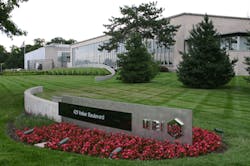Midwest Research Institute renovates HQ, earns LEED certification
KANSAS CITY, MO. — Midwest Research Institute (MRI), one of the nation's independent scientific research organizations, recently earned U.S. Green Building Council LEED certification for the 80,000-sq.ft renovation of two wings in its headquarters facility here. Operating within the original building footprint, the 250,000-sq.ft facility is utilizing sustainable products and systems to conserve energy and water.
Completed January 2009, the goals of MRI's two-year renovation project were to solve its space constraints and provide a facility that contributes to a sustainable environment. So far energy conservation has resulted in a reduction of nearly 600 metric tons of carbon dioxide when comparing adjusted energy usage data from the years 2008 to 2009.
According to Mark Breitenstein, MRI's director of facilities management, the project was challenging due to the nature of the facility being mostly laboratory space.
“We went from mostly office area to mostly lab area,” explained Breitenstein. “Most labs consume four to five times the energy of office space. The renovated areas seem to be far more efficient per square foot than the non-renovated areas.”
PGAV Architects, Westwood, Kan., designed the renovation, J.E. Dunn Construction Group Inc., Kansas City, Mo., was responsible for the construction, and Rand Construction Co., Kansas City, Mo., installed the plumbing and HVAC systems.
According to Frederick Thorpe, vice president of the Commercial/HealthCare Division of Rand Construction Co., there were a few challenges to this project, but all were overcome.
“The drawings were not 100% complete,” explained Thorpe. “Parts of the project were designed, other parts were not, and some of the project was awarded to Rand as design/build where we ended up generating the drawings and taking them to the city for permitting. Trying to keep all these different requirements straight with our field personnel was a bit of a challenge, but we overcame this.”
Opportunities to reuse the building shell, move mechanical needs to the roof and modernize central utilities allowed the original building footprint to remain unchanged.
According to Breitenstein, the project plans were very creative in the use and maximization of space.
“We installed new energy-efficient air handling units on the roof and ran the ductwork from each unit across the roof down the side of the building or down chases to keep the footprint of the building intact,” explained Thorpe.
Features contributing to USGBC LEED status include upgrading 60% of the plumbing fixtures with Eljer and Kohler low-flow plumbing fixtures; improving the central heating with energy-efficient products, such as Carrier chillers and air handlers, and Bell & Gossett pumps; replacing 40 laboratory hoods with new low-flow hoods; and replacing 40 separate hood exhaust fans with 14 fans.
The renovated areas save nearly 19% in energy costs compared to the baseline established by ASHRAE Standard 90.1-2004, and the high-efficiency plumbing fixtures reduce the volume of water used in the facility by nearly 29%, according to Breitenstein.
“Results of the renovation have been extremely successful," said Breitenstein. "We have a state-of-art facility that provides an enhanced work environment for staff, it accommodates growth, and the LEED certification validates MRI's mission to support a sustainable future. MRI's renovation demonstrates that green choices do have a positive impact on older facilities."
The renovation also included replacing 98% of the T-12 lighting with high-efficiency T-8 fixtures or retrofits; using day lighting to lower lighting requirements; installing sensors to shut off lighting in unoccupied areas; and utilizing white reflective material in newer roof areas, cutting daytime summer heat load by at least 17%.
"Through the design plan, MRI's aging office space and underutilized areas were transformed into an energizing and efficient combination of modular laboratory and open collaborative office space," said Mike Schaadt, vice president of PGAV. "The renovated area was reconfigured to draw in more natural light, increase systems efficiency, allow transparency into the laboratory space and allow staff to collaborate."
MRI, a not-for-profit scientific research organization, performs contract research and laboratory consulting services for clients in government, industry and academia. Established in 1944, MRI conducts research in the areas of national security and defense, energy and environment, life sciences, agriculture and food safety, and infrastructure. MRI is one of two entities in the Alliance for Sustainable Energy LLC that manages and operates the National Renewable Energy Laboratory, Golden, Colo., for the U.S. Department of Energy.
About the Author
Candace Roulo
Candace Roulo, senior editor of CONTRACTOR and graduate of Michigan State University’s College of Communication Arts & Sciences, has 15 years of industry experience in the media and construction industries. She covers a variety of mechanical contracting topics, from sustainable construction practices and policy issues affecting contractors to continuing education for industry professionals and the best business practices that contractors can implement to run successful businesses.
